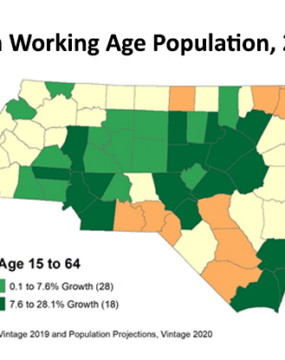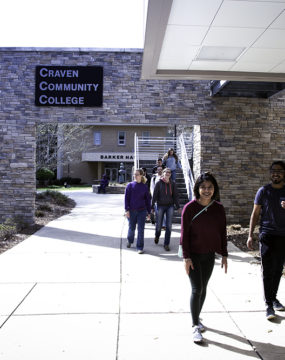Economic Data
Keep up with our latest demographic insights

The labor force participation rate describes the percentage of people 16 or older who are working or actively looking for work. Nationally, the seasonally-adjusted labor force participation rate for the United States in June 2021 was 61.6%. In North Carolina, the participation rate was 59.2%, 2.4 percentage points below the national rate. Why does the labor force participation rate matter and what does it tell us? The labor force participation rate is a measure of how…

Dr. Michael Cline is the state demographer for North Carolina at the Office of State Budget and Management and has given us permission to re-post his content here. Each year, he publishes population estimates and projections for North Carolina and its counties. April marked the second month in a row that the Bureau of Labor Statistics reported a record number of open jobs. A recent study by the National Federation of Independent Businessesfound that nearly…

Over the past year, the economic impact of COVID-19 has been at the forefront of pandemic response and state-wide reopening plans. In March 2020, businesses across the country closed – some of which have never reopened – resulting in unemployment levels that surpassed unemployment rates of the Great Recession in 2008. Although unemployment rates have improved, they have not fully recovered from a year ago. Those living in the U.S. have had to increasingly rely…

April 15 would normally mark Tax Day, the federal income filing deadline. Due to the coronavirus pandemic, Tax Day is now extended three months to July 15. Instead, as the U.S. ends its first month of widespread social distancing, many American households may receive their federal stimulus check this week. These stimulus checks – also known as Economic Impact Payments – will be as much as $1,200 per person, but not everyone will qualify. I…

The United States economy is primarily driven by the economic activity within its metropolitan areas. From 2012 to 2017, 90% of the nation’s annual GDP was contributed by the nation’s 383 metros. This is to be expected, as 86% of the US population lives in a metropolitan statistical area. North Carolina follows a similar trend. In 2017, the state’s overall GDP was approximately $540 billion, and the combined metros totaled $476 billion, or 88%, of…

Yesterday’s post provided topline statistics about internet access in North Carolina. For many readers, this post raised more questions than it answered. Specifically, one reader wanted to know how many individuals had internet access only through their cell phones. Others had more specific questions about the relationship between income, geography, and access. These questions are addressable with the data and are the focus of this post. How many of the people with internet access are…

Just over 656,000 veterans lived in North Carolina in 2017 according to the most recent American Community Survey estimates. This is a decrease of 10,000 veterans from 2016, a decline of 1.5 percent. Nationally, the veteran population decreased at a similar rate, declining from 18.5 million in 2016 to 18.2 million in 2017, a loss of 292,000 on veterans. While the veteran population has been steadily declining, the total adult population continues to grow. As…

Colleges and universities can have a significant impact on local demographic and economic statistics. College towns tend to see inflated poverty rates: more off-campus students (as share of population) corresponds to higher poverty rates. In Boone, North Carolina, for example, off-campus students at Appalachian State University make up 57% of the local population* and the local poverty rate is 62%. Some of these poor individuals may be college students who are choosing not to work…

Turkey production is important to the farming sector of North Carolina. In fact, total poultry production – including turkeys, eggs and broiler chickens – is North Carolina’s top agricultural industry, making up 40% of the state’s farm income. Data from the USDA on “turkey disappearance” per capita in the United States indicated a slight uptick from about 16 pounds annually from 2012-2015 to over 16.5 pounds in 2016 and 2017 (projected). As poultry consumption increases…

North Carolina’s agricultural industry contributes $84 billion to the state’s economy and employs more than 1 in 6 North Carolina Workers, according to the Department of Agriculture & Consumer Services. Two of the state’s lead agricultural products—sweet potatoes and turkeys—will grace many Thanksgiving tables on Thursday. Here’s a quick look at sweet potatoes by the numbers: 1st North Carolina’s rank in sweet potato production. North Carolina has led the nation in sweet potato production since…
Your support is critical to our mission of measuring, understanding, and predicting population change and its impact. Donate to Carolina Demography today.